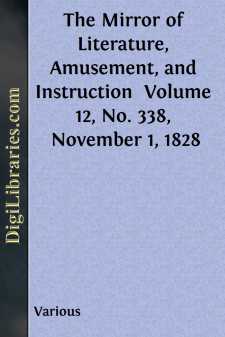Categories
- Antiques & Collectibles 13
- Architecture 36
- Art 48
- Bibles 22
- Biography & Autobiography 813
- Body, Mind & Spirit 142
- Business & Economics 28
- Children's Books 14
- Children's Fiction 11
- Computers 4
- Cooking 94
- Crafts & Hobbies 4
- Drama 346
- Education 46
- Family & Relationships 57
- Fiction 11829
- Games 19
- Gardening 17
- Health & Fitness 34
- History 1377
- House & Home 1
- Humor 147
- Juvenile Fiction 1873
- Juvenile Nonfiction 202
- Language Arts & Disciplines 88
- Law 16
- Literary Collections 686
- Literary Criticism 179
- Mathematics 13
- Medical 41
- Music 40
- Nature 179
- Non-Classifiable 1768
- Performing Arts 7
- Periodicals 1453
- Philosophy 64
- Photography 2
- Poetry 896
- Political Science 203
- Psychology 42
- Reference 154
- Religion 513
- Science 126
- Self-Help 84
- Social Science 81
- Sports & Recreation 34
- Study Aids 3
- Technology & Engineering 59
- Transportation 23
- Travel 463
- True Crime 29
The Mirror of Literature, Amusement, and Instruction Volume 12, No. 338, November 1, 1828
by: Various
Categories:
Description:
Excerpt
Nelson's Monument, at Liverpool.
(To the Editor of the Mirror.)
In No. 270 of the MIRROR, you favoured us with a correct engraving of the Town Hall, Liverpool, and informed us of a trophied monument erected to the memory of Nelson in the Liverpool Exchange Buildings. Of the latter I am happy to be able to present you with the above view.
The monument, executed in bronze by Richard Westmacott, Esq. R.A. is erected in the area of the Liverpool Exchange Buildings, and was completed in October, 1823. The subscription amounted to about 9,000l. The weight of the bronze of which it is composed is estimated at upwards of 22 tons. The figures are in the proportion of seven feet.
On a basis of Westmoreland marble stands a circular pedestal of the same material, and peculiarly suitable in colour to the group which it supports. At the base of the pedestal are four emblematic figures, in the character of captives, or vanquished enemies, in allusion to Lord Nelson's victories. The spaces between these figures, on the sides of the pedestal, are filled by four grand bas-reliefs, executed in bronze, representing some of the great naval actions in which Nelson was engaged. The other parts of the pedestal are richly decorated with lions' heads and festoons of laurel; and in a moulding round the upper part of it is inscribed, in brass letters, pursuant to the resolution of the general meeting, that most impressive charge delivered by the illustrious commander previous to the commencement of the battle of Trafalgar, "ENGLAND EXPECTS EVERY MAN TO DO HIS DUTY."
The figures constituting the principal design are Nelson, Victory, and Death: his Country mourning for her loss, and her Navy, eager to avenge it,—naturally claim a place in the group.
The principal figure is the Admiral, resting one foot on a conquered enemy, and the other on a cannon. With an eye stedfast and upraised to Victory, he is receiving from her a fourth naval crown upon his sword, which, to indicate the loss of his right arm, is held in his left hand. The maimed limb is concealed by the enemy's flag, which Victory is lowering to him. Under the folds of the flag Death lies in ambush for his victim, intimating, that Nelson received the reward of his valour and the stroke of death at the same moment.
By the figure of an exasperated British seaman is represented the zeal of the navy to wreak vengeance on the enemies who robbed England of her gallant leader.
Britannia, with laurels in her hand, and leaning regardless of them on her spear and shield, describes the feelings of the country fluctuating between the pride and the anguish of triumph so dearly purchased, but relying for security on her own resources.
Hoxton. T. WARD.
TAKING OF CONSTANTINOPLE BY THE TURKS.
(For the Mirror.)
Mahomet II., soon after he mounted the Turkish throne, resolved to achieve some glorious action, that he might surpass the fame of his predecessors; and nothing appeared so compatible with his ambition as the gaining of Constantinople, and the total subversion of the Greek empire, which at that period was in a very precarious condition....












